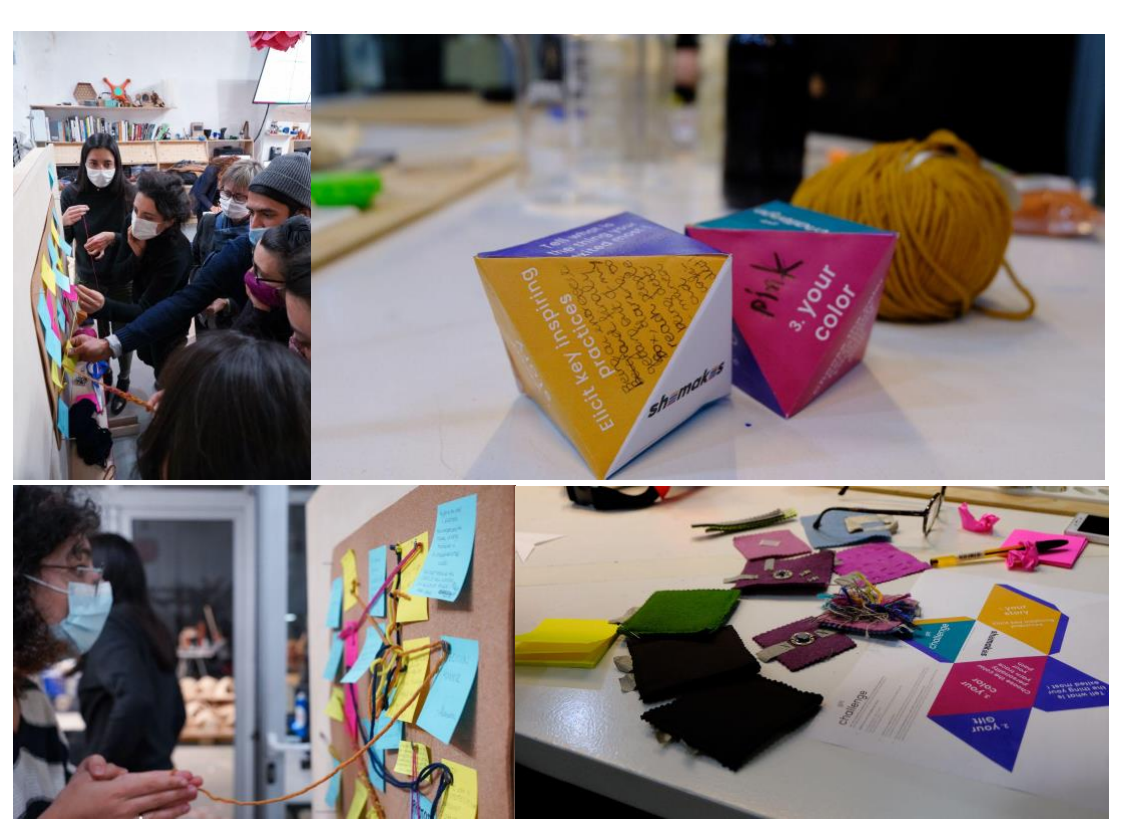Gift weave Challenge
The Gift Challenge

This workshop has been conceived to support knowledge transfer and to identify the key and contribution (the gift) that consortium members and particularly Gurus can give to the next phase of the project. We believe that each of the shemakes roles can contribute in a particular form: on a personal level with their motivation, commitment, competencies and skills; on a community level by sharing values that strengthen the shemakes network. Thus, we aim to promote the growth of leaders who guide with confidence, respect, and courage, which are the values we hope will support the community's development with positive changes. Ultimately this dynamic is created to strengthen the network and understand how we can collaborate and support each other with the analogy of fibres and textiles that weave stronger fabrics "shemakes weave".
This process helps us explore the following things about people.
Sharing their stories of what inspired them to become a Guru, what marked their lives and defined their career paths; with the goal of connecting and empathising with the three types of audience: children, youngs and adults.
A unique contribution that the Gurus provide to the project and beyond that to the world, which can be represented in an artefact or in their knowledge that they want to pass on from one generation to another (Tell us what you are most excited about).
Their mood and the way the person imprints daily life. It also represents their personality. In other words, with this part we want to understand how emotions can create synergies in a group.
THE MURAL
The activity is carried out with the Ambassadors to understand their missiondriven pursuit, to contribute and expand the network the “shemakes weaving”. Thus, Ambassadors can first recognise each Guru's support role in carrying out the activities in the transfer labs. Additionally, they can help each other and share their experiences, stories and skills as "gifts" for our shemakes community.
-min.png?inline=false)
How to do an intangible gift exchange
-min.png?inline=false)
-min.png?inline=false)
There are a series of steps we’ve established to help people identify and communicate their unique gift, and then “weave” it together as a community. You can instruct people to do all the steps in your intangible gift exchange or make it simpler and more informal by doing just the first step.
-min.png?inline=false)
WHAT YOU WILL NEED
STEPS OF THE GIFT WEAVE
1. Identify your gift. Ask people: What is your unique contribution to the world? It might be a hard skill (like knowing how to cross-stitch or being good at creating complex excel tables) or a soft skill (like being good at getting everyone to agree). People might be asked this question in advance so they can think about the best way to present it, and bring an object or example if that’s relevant.
2. What’s the story behind your gift? Skills don’t come from nowhere. Perhaps your skill is a traditional weaving technique from your community, that you learned from a great aunt. Or your skill is photography because it was your father’s hobby. The way we become the way we are, the way we learn our most important skills, superpowers or gifts, is all part of a story, and the story is always interesting to other people who want to get to know you better. A good story may stem from different stages of your life (like “when I was a little girl, I was shy), and perhaps it will include a challenge you’ve overcome, a need you’ve solved or an opportunity you’ve taken.
3. What’s your group personality trait? To help people express their superpowers and form a stronger network, we thought of the main ways that people contribute to group exchange. They may define themselves as being: an energizer, a listener, a decision maker, the sidekick, or particularly experienced. You can ask people to write this trait on a post-it with their name. Knowing how people interact in a group can help you create balanced smaller working teams, for example.
4. What colour represents your personality? Starting from the four colours of shemakes, the colour expert in our team set out four standard profiles of personality types (usually the colours used are red, blue, white and yellow but we modified them a bit). With our colours we defined people who tend to be intimate, powerful, peaceful and fun. We used yarn to visualize these traits, which of course can be all present in a single person, so some of our participants made twists or braids of their different traits using the coloured yarn.
As people define elements from these steps, ask them to write post-its and pin them to a pin-board. Then, use yarn to “weave” connections between people, thinking about needs, desires or potential collaborations. For example, in our group, a very creative person with numerous skills connected herself to a person who defined herself as a powerful decision maker, because the first woman found it hard to make decisions and organize her path.
Finally, ask people to share their gifts and stories one by one. If possible, create a relaxed situation for this – in a circle or on couches – and make sure to leave plenty of time so everyone can talk. Ensure that it is a safe space and encourage everyone’s gifts without comment.
Lessons learned :
Through sharing a safe space, each participant told their own story about their experiences and presented tangible artefacts, with contributions through teaching, passion for technology, science and exploration of new challenges.
In an open discussion each member offered a “gift” motivating all types of audience and transmitting their passion to the project with some of the stories: